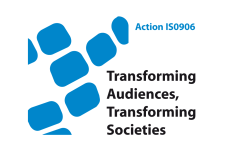- About the Action
- Events
- PhD workshop - Ljubljana 2014
- Action Open Conference - Ljubljana 2014
- New Media and Participation conference - Istanbul 2013
- Belgrade meeting 2013
- Media literacy research and policy - Brussels 2013
- ICA Pre-Conference 2013
- Tampere meeting 2013
- Budapest workshop 2012
- Milan meeting 2012
- Brussels PhD workshop 2012
- Brussels Action workshop 2012
- London meeting 2011
- Zagreb Conference 2011
- Lisbon meeting 2010
- Affiliated events
- WG 1
- WG 2
- WG 3
- WG 4
- Cross-WG
- Output
Do current media developments ask for new literacies? The case of social network sites
Trültzsch-wijnen, S., Wijnen (First Author) (2011). Do current media developments ask for new literacies? The case of social network sites. IAMCR conference 2011: "Cities, Creativity, Connectivity". 13-17 July.
Abstract: Current social web developments offer various possibilities for communication, participation, self presentation and the acquirement of knowledge. Recent studies have shown that young people use especially social network sites (SNS) to present themselves, to manage relationships and to communicate with their peers (boyd 2008; Ito et al. 2008; Paus-Hasebrink et al. 2009; Tarazow et al. 2010; Valkenburg/Peter 2010). On the one hand social web applications like SNS offer various chances and opportunities – especially with regard to participation and citizenship. But on the other hand SNS can evoke several risks, as well. These risks refer to content (e.g. sharing of x-rated photos and videos); underestimation of the reach of global networks (e.g. personnel recruiters investigating SNS accounts, grooming strangers etc.); underestimation of sustainability (e.g. virtual “youthful follies” that can still be found online when they are already forgotten); underestimation of the dynamic of interactions (e.g. fast circulation/linking of messages, unwanted tagging of photos etc.); and the collection and misuse of data (Lampert et al. 2009; Schmidt et al. 2010). By referring to different empirical studies on the behavior of young people on SNS (including an own study on the handling of privacy) we will discuss various definitions of literacy (respectively different literacies). With special focus on the possibilities of SNS for citizenship and participation in society as well as the fact that sociocultural aspects like education and socioeconomic or migrational background have influence on the way young people are coping with risks and making use of chances (e.g. Schmidt et al. 2009), we will discuss the boundaries of old concepts of literacy as well as recent advancements of the concept of media literacy (e.g. Jenkins et al. 2006 or James et al. 2008). We will question how media literacy can be developed according to the current and upcoming medial and cultural changes by young people themselves and to what extent media education is needed to avoid digital divide.. In this context the potential of media education as well as it’s frontiers with regards to media literacy, citizenship and participation will be elaborated. boyd, d. (2008): Taken Out of Context: American Teen Sociality in Networked Publics. PhD Dissertation. University of California-Berkeley, School of Information. Ito, M. et al. (2008): Living and Learning with New Media: Summary of Findings from the Digital Youth Project. University of Southern California/University of California, Berkeley. Online document: http://www.macfound.org. (2011-01-20) James, C. et al. (2008): Young people, Ethics, and the New Digital Media: A Synthesis form the Good Play Project. In: GoodWork Project Reports Series, No. 54. Online document: http://www.pz.harvard.edu/eBookstore/PDFs/GoodWork54.pdf (2011-01-20) Jenkins, H. et al. (2006): Confronting the Challenges of Participatory Culture: Media Education for the 21st Century. Online document: http://www.digitallearning.macfound.org/atf/cf/%7B7E45C7E0-A3E0-4B89-AC9CE807E1B0AE4E%7D/JENKINS_WHITE_PAPER.PDF (2011-01-20) Lampert, C., Schmidt, J. & Schulz, W. (2009): Jugendliche und Social Web – Fazit und Handlungsbereiche. In: J. Schmidt, I. Paus-Hasebrink I. & U. Hasebrink (Eds.): Heranwachsen mit dem Social Web. Zur Rolle von Web 2.0-Angeboten im Alltag von Jugendlichen und jungen Erwachsenen. Berlin: Vistas. 275-297. (Young people in social web – conclusions and ways for action) Paus-Hasebrink, I./XXX/Brüssel, T. (2009): Social Web im Alltag von Jugendlichen und jungen Erwachsenen: Soziale Kontexte und Handlungstypen. In: Schmidt, J./Paus-Hasebrink, I./Hasebrink, U. (Eds.): Heranwachsen mit dem Social Web. Zur Rolle von Web 2.0-Angeboten im Alltag von Jugendlichen und jungen Erwachsenen. Berlin: Vistas, pp. 121-206. (Social web in the daily lives of young people. Social contexts and user typologies) Schmidt, J., Lampert C. & Schwinge C. (2010): Nutzungspraktiken im Social Web – Impulse für die medienpädagogische Diskussion. In: B. Herzig, D. M. Meister, H. Moser & H. Niesyto (Eds.): Jahrbuch Medienpädagogik 8. Medienkompetenz und Web 2.0. Wiesbaden: VS Verlag. pp. 255-270. (Ways of using social web – stimuli for discussions on media education) Taraszow, T./Aristodemou, E./Shitta, G./Laouris, Y./Arsoy, A. (2010): Disclosure of personal and contact information by young people in social networking sites: an analysis using FacebookTM profiles as an example. International Journal of Media and Cultural Politics 6 (1), pp. 81-102. Valkenburg, P./ Peter, J. (2010): Communicating online. In: de Haan, J./ Pijpers, R. (Eds.) Contact! Children and New Media. Houten: Bohn Stafleu van Loghun, pp. 89-102.

